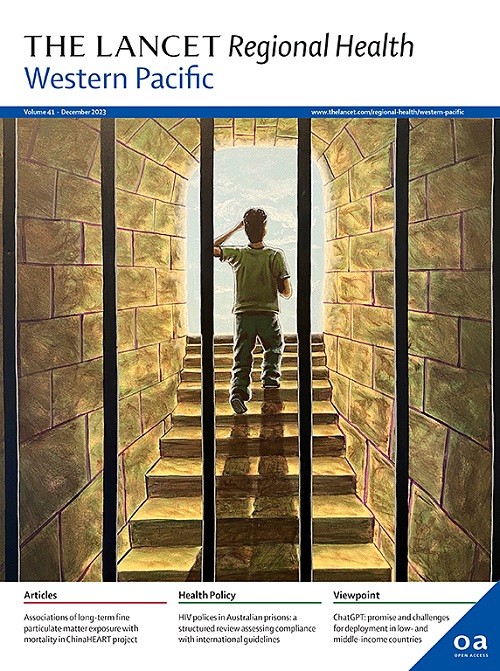识别和可视化2型糖尿病患者因传统和非传统并发症住院的时间轨迹:一项基于人群的研究
IF 7.6
1区 医学
Q1 HEALTH CARE SCIENCES & SERVICES
引用次数: 0
摘要
背景2型糖尿病患者越来越容易出现非糖尿病特有的并发症。我们的目的是检查2型糖尿病患者因传统和非传统并发症住院的时间轨迹。方法:我们纳入了2002年至2018年间香港758254例2型糖尿病患者,随访至2019年。我们纳入了72种选定疾病和全因死亡的住院情况。我们基于疾病关联对推导出住院的时间轨迹,并使用马尔可夫聚类算法确定轨迹聚类。在中位随访7.8年(IQR: 4-12)期间,57.6%的人因72种选定疾病中的任何一种住院治疗,22.6%的人死亡。在5184对定向病对中,鉴定出95对具有显著的定向关联。三种最常见的疾病对是尿路感染住院,其次是肺炎;缺血性心脏病住院,其次是心力衰竭;缺血性中风住院,其次是肺炎。心血管疾病和肾脏疾病在住院轨迹中占主导地位。然而,这些传统并发症在它们之间以及与跨多个系统的各种非传统并发症之间具有复杂的关联。确定了三个不同的轨迹簇,以心力衰竭/慢性肾脏疾病、肺炎和尿路感染为中心疾病。心血管和肾脏疾病与一系列广泛的非传统并发症相互作用,影响糖尿病患者住院进展的整体模式,突出了拓宽糖尿病护理的必要性,以考虑传统焦点以外的并发症。香港中文大学直接研究资助。本文章由计算机程序翻译,如有差异,请以英文原文为准。
Identifying and visualising temporal trajectories of hospitalisations for traditional and non-traditional complications in people with type 2 diabetes: a population-based study
Background
People with type 2 diabetes are increasingly susceptible to complications that are not specific to diabetes. We aimed to examine the temporal trajectories of hospitalisations for traditional and non-traditional complications in people with type 2 diabetes.
Methods
We included 758,254 people with incident type 2 diabetes between 2002 and 2018 in Hong Kong, followed up until 2019. We included hospitalisations for 72 selected diseases and all-cause deaths. We derived the temporal trajectories of hospitalisations based on pairs of disease associations and identified trajectory clusters using Markov Cluster Algorithm.
Findings
During a median follow-up of 7.8 (IQR: 4–12) years, 57.6% of people experienced a hospitalisation for any of the 72 selected diseases and 22.6% of people died. Among the 5184 directional disease pairs, 95 were identified as having a significant and directional association. The three most common disease pairs were hospitalisations for urinary tract infection followed by pneumonia, ischemic heart disease followed by heart failure, and ischemic stroke followed by pneumonia. Cardiovascular and kidney diseases were predominant in the hospitalisation trajectories. However, these traditional complications had complex associations both among themselves and with various non-traditional complications across multiple systems. Three distinct trajectory clusters were identified, with heart failure/chronic kidney disease, pneumonia, and urinary tract infection as central diseases.
Interpretation
Cardiovascular and kidney diseases interacted with a broad set of non-traditional complications to influence the overall patterns of hospitalisation progression in people with diabetes, highlighting the need to broaden diabetes care to consider complications beyond the traditional focus.
Funding
Direct Grant for Research from The Chinese University of Hong Kong.
求助全文
通过发布文献求助,成功后即可免费获取论文全文。
去求助
来源期刊

The Lancet Regional Health: Western Pacific
Medicine-Pediatrics, Perinatology and Child Health
CiteScore
8.80
自引率
2.80%
发文量
305
审稿时长
11 weeks
期刊介绍:
The Lancet Regional Health – Western Pacific, a gold open access journal, is an integral part of The Lancet's global initiative advocating for healthcare quality and access worldwide. It aims to advance clinical practice and health policy in the Western Pacific region, contributing to enhanced health outcomes. The journal publishes high-quality original research shedding light on clinical practice and health policy in the region. It also includes reviews, commentaries, and opinion pieces covering diverse regional health topics, such as infectious diseases, non-communicable diseases, child and adolescent health, maternal and reproductive health, aging health, mental health, the health workforce and systems, and health policy.
 求助内容:
求助内容: 应助结果提醒方式:
应助结果提醒方式:


